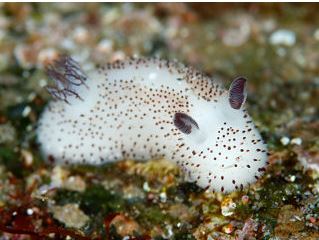BY KAIA KARPE
STAFF WRITERS
The Sea Bunny is an awfully cute creature. It caught my eye because it looked like a bunny with the ears, but they weren’t normal bunny ears. Sea Bunnies genus name is Jorunna parva. Over the course of this article I will explain its “ears”, diet, method of reproduction, where it is located, and how it gets around. Get ready to fall in love with one of the ocean’s most adorable molluscs!
Some say its cute appearance can just say everything about it, but that isn’t true. They can be located in specific locations along coasts. The Sea Bunnies are a type of Sea Slug. They usually are located in the coasts of Korea, Palau, Japan, Indonesia, Philippines, Papua New Guinea, South Africa, Australia, Tanzania, and Seychelles because they like tropical waters. These cute creatures like areas with a surplus of food, and where the requirement for resources are easily met. Sea Bunnies aren’t that picky about their location, they just ask for a reasonable amount of sponges, and a coast to live on.
The Sea Bunnies ears and fur are not what they seem. Sea Bunny’s ears are NOT ears, but sensory organs called rhinophores. Rhinophores are used to help find its way around since it doesn’t have eyes. The little flaps on the rhinophores increase the ability to detect their surrounding environment. Also, the flower shaped appendages near its butt are actually the Sea Bunnies gills so they don’t drown because they are so slow. “Fur” on the Sea Bunny is called caryophyllidae. It is composed of fleshy protuberances called papillae; also used to identify its surroundings, kind of like a manatee. All in all, the SEA Bunnies can’t SEE, so they use its ears, or fur to locate things.
Generally speaking, Sea Bunnies seem like they would have many predators after them, but they’ve found a way to defend themselves. Jorunna parvas eats sponges, which contain toxins, and uses the sponge’s toxic defenses to protect itself from predators. Toxins in the sponges can not only be used as food for the Sea Bunnies, but it can be used in treatments to help people with cancer.
Other fascinating aspects of the Sea Bunny’s life include: how they reproduce, how big they are, how long they live, and what colors they come in. Sea Bunnies are a hermaphrodite, which means they can produce both sperm and egg cells. The Sea Bunny is about 2.5 centimeters or one inch long. Sea Bunnies can appear in different colors, which there is debate about if the Sea Bunnies with different colors are a different species. They can come in colors of yellow with black, and a light green. Sea Bunnies can live a couple months to a year.
Even though the Sea bunnies may be tiny, they live a short life, but they can be strong and protect themselves from predators.
